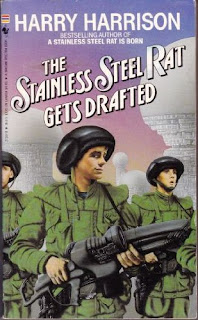1987;
262 pages. New Author? : No. Genre : Science Fiction; Humor & Satire. Book #2 (in the series timeline) or Book #7
(in the order they were written) in the 12-book Stainless
Steel Rat series. Overall Rating
: 7*/10.
This is the all-too-soon end for young Jimmy diGriz,
aka The Stainless Steel Rat. He’s
hanging by his fingertips at the top of an elevator shaft, with a fall of more
than a kilometer (several
hundred stories’ worth) in his immediate future, as soon as the
strength in his fingers gives way.
At
least he’ll die doing what he’s best at – escaping. In this case, it’s from a high-security
prison after the nefarious Captain Garth double-crossed him. And even if Jim somehow manages to survive
his present predicament, he’d be alone and penniless on a foreign planet.
Well,
suck it up, diGriz. You’re the
Stainless Steel Rat, and if you’re worthy of your reputation, however short-lived it may be, you’ll think of something.
Before you get splattered all over the roof of that elevator car a long,
long way below.
What’s To Like...
The Stainless Steel Rat Gets Drafted is the second
book (timeline-wise) in Harry Harrison’s Stainless Steel Rat series. The storyline picks up almost immediately
after Book One (reviewed here), with our anti-hero protagonist, Jimmy
diGriz, escaping from his life-or-death situation (Oh, come on now, this isn’t a
spoiler. He’s the hero of the series.)
and his subsequent escapades, including the titular predicament of being
drafted.
I
liked the world-building and the wit.
The technology may be 25th-century – including such critter
gizmos like spyrats, communications moths, and radio crows – but humanity has
not evolved a whit. There are still wars
and invasions, drill sergeants and double-dealers, and new “isms” looking for
converts.
I
chuckled at some of the details Harry Harrison weaves into the story. There’s “kewarghen” (think ‘pot’) and
uppers., and a bit of cross-dressing as well.
I liked the use of a made-up, all-purpose cussword, “cagal”. It gets the idea across without offending the
more prudish readers. Authors of
science-fiction and fantasy should really adapt this literary device. I also liked Harrison’s nod to Esperanto, the best candidate for a universal language, and the least-likely to become so.
Beneath all the fun and thrills, Harry Harrison offers his opinions on a couple more-serious topics. The whole idea
of the draft is examined, which young‘uns might have trouble relating to in this
day of a volunteer army here in the US. But us old
geezers remember it all too well. There
are also some interesting insights concerning spiritual fads. In this case, the new rage is something “Individual
Mutualism”.
The story is told in the first-person POV (the Stainless Steel Rat’s).
There are 31 chapters covering 262 pages, so there’s always a good place
to stop for the night. This is a self-contained story, besides being part of the series. I had mixed feelings about the ending. On one hand, a bloodless, planetary invasion
strained the limits of believability for me.
OTOH, I think this was deliberate on Harry Harrison’s part, and hats off
to him for even trying to pull it off.
Kewlest New Word. . .
Chuntering (v.)
: muttering or grumbling incessantly in a meaningless fashion. A Britishism.
Others
: Eructation (n.);
Fug
(n.); Insufflated (v.).
Excerpts...
“You entered this
room as fun-loving youths. You will
leave it as dedicated soldiers. You will
now be sworn in as loyal members of the army.
Raise your right hands and repeat after me…”
“I don’t want
to!”
“You have that
choice,” the officer said grimly. “This
is a free country and you are all volunteers.
You may take the oath. Or if you choose not to, which is your right, you may leave by the small door behind me
which leads to the federal prison where you will begin your thirty-year
sentence for neglect of democratic duties.”
“My hand’s up,”
the same voice wailed. (pg. 66)
I turned to thank
Neebe, the gorgeous brown-limbed redhead who was president of the cycling club,
but she was just passing the club flag to her second-in-command. Then she wheeled her bike toward me, smiling
a smile that melted my bike handles.
“May I be very
forward, offworlder James deGriz, and force my presence upon you? You have to but say no and I will go.”
“Glug …!”
“I assume that
means yes.” (pg. 230)
I am. Therefore I think.” (pg. 168)
There were a couple of negatives, albeit it, minor ones.
The pacing felt slow for the first half of The
Stainless Steel Rat Gets Drafted, although it picks up nicely in the
second. Even so, it slowed down again,
for a bit, when the tenets of Individual Mutualism were expounded upon.
Then there was Bibs. She gets
introduced early in the story, is fully developed, then disappears, never to
return again. Finally, the whole “rising through the ranks” shtick, while droll, was just too unbelievable for me.
But I quibble.
Overall, this was still a good read, although not quite on a par with its
predecessor, The Stainless Steel Rat Is Born. I have three other books of the series
sitting on my TBR shelf, as well as Harry Harrison’s West
of Eden, so we shall see which of the two HH books I’ve read so far is
representative of the quality of his writing.
7 Stars. I
moved this book to the top of my reading list because of Andy Wallace, author
of Origins, and reviewed here, cites
it as the inspiration for his book. High
praise, indeed; so don’t take my review as the final word on The Stainless Steel Rat Gets Drafted.




